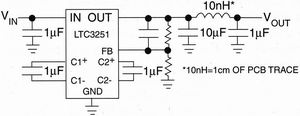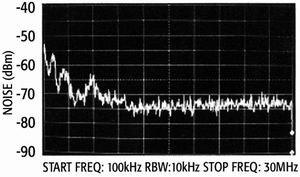This year, it is expected to sell more than 450 million mobile phones, 35 million notebook computers and 12 million personal digital assistants (PDAs) . These products are identical in two points: first, they are battery powered; second, they all have some form of noise-sensitive radio frequency circuit ( or additional circuit ) . Obviously, mobile phones always use sensitive RF transceiver circuits, but the addition of such circuits in PDAs and handheld computers is a recent thing. This part is the result of the development of Bluetooth technology. At the same time, in such products, switching power supplies are gradually replacing linear regulators to extend battery life. The presence of noise sources ( switching power supplies ) and noise-sensitive circuits in the product may cause interference risks.
The traditional solution is to keep the noise source circuit away from noise-sensitive circuits as much as possible. However, in today's handheld products, the design is very compact, so this method is no longer feasible , and solving the problem by adding shielding is not feasible in terms of cost and volume. The noise energy of the traditional switching power supply is mainly expressed in the form of concentrated narrow-band harmonics. However, if one of these harmonics happens to coincide with or is very close to a sensitive frequency ( such as the intermediate frequency passband of the receiver ) , it is likely Cause interference.

Picture 1 Â Simplified block diagram of a non-inductive spread spectrum DC / DC converter

Picture 2 Â LTC3251 Buck Converter

Picture 3 Â LTC3251 's output noise spectrum when using a 10mF output capacitor (IO = 500mA)

Picture 4 Â When the input noise spectrum using 1mF input capacitance (IO = 500mA) LTC3251 of
DC / DC (DC / DC) converter system clock is a dither technique was successfully employed. This method uses a pseudo-random sequence (PRN) to modulate the switching frequency through spread spectrum technology , thereby eliminating narrow-band harmonics. In essence, this method is to "scatter" the noise over the entire frequency range, instead of focusing on specific harmonics. Because the peak amplitude of the spread spectrum noise is much lower, the interference is greatly reduced. In the past, this technology was implemented as a discrete device, but now with the advancement of technology, spread-spectrum technology is integrated in newer DC / DC converter devices, which can greatly save space.
Monolithic IC low noise solution supporting spread spectrum operation
To understand how to implement spread-spectrum operations on-chip, let us take the block diagram shown in Figure 1 as an example. The two-phase switched capacitor charge pump in Figure 1 is used to step down the input voltage to obtain a stable output voltage. An external resistor divider is used to detect the output voltage, and the error signal is used to modulate the output current of the charge pump to achieve voltage regulation. A two-phase non-overlapping clock is used to excite these two charge pumps. The two charge pumps work in parallel, but in opposite phases. In the first phase of the clock, the current from VIN reaches VOUT through the switch of the charge pump 1 and the external floating capacitor 1 . During the first phase of the clock, current is transferred to VOUT and the floating capacitor is also charged. During the second phase of the clock, the floating capacitor 1 is connected from VOUT to ground, and the charge stored during the first phase of the clock is transferred to VOUT through the switch of the charge pump 1 . The charge pump 2 works in the same way, but the phase is opposite to the charge pump 1 . This two-phase structure greatly reduces output and input noise by continuously transferring charge from VIN to VOUT .
With this switching method, only half of the output current comes directly from VIN , and the efficiency can be increased by 50% compared to traditional low-dropout (LDO) regulators . The spread spectrum operation is implemented in such a way that the oscillator frequency is modulated on a clock cycle basis according to the change of the pseudo-random number. Only a few percent modulation of the operating frequency of the oscillator can significantly reduce peak and harmonic noise.
Linear Technology's LTC3251 is one of the ICs that integrates on-chip spread-spectrum functions . LTC3251 is a high efficiency, low noise, non-inductive step-down DC / DC converter with an output current of 500mA . The spread spectrum oscillator in the LTC3251 is designed so that the clock pulse width of each cycle varies randomly, and the frequency range is limited to 1 ~ 1.6MHz . The advantage of this is that the switching noise is dispersed in a wide frequency range. Figure 2 shows a typical application circuit of the LTC3251 . Figures 3 and 4 are the output and input noise spectrum of the LTC3251 in Figure 2 at VIN = 3.6V , VOUT = 1.5V, and IOUT = 500mA . Due to the use of spread-spectrum technology, the peak output noise can be significantly reduced (20dBm) with only half of the original output capacitance , and the input harmonics are almost eliminated with only a tenth of the original input capacitance. Spread spectrum technology is dedicated to "continuous" mode and Burst Mode when the output current is greater than 50mA .
To meet the requirements of handheld applications for powerful functions, wireless portability, and reasonable battery life, designers had to integrate high-efficiency switching power supplies and noise-sensitive RF circuits. The traditional switching power supply structure can extend the battery life, but may require costly and space-consuming filtering or shielding technology. However, there are now power ICs with "built-in" spread-spectrum switching functions . With this type of IC , even without using traditional methods, it can alleviate the harmonic interference experienced by sensitive RF circuits. Moreover, these small, relatively high output current and low noise power ICs are ideal for space-limited, battery-powered applications.
GrandComm provides professional Wireless modems for varies applications. With these Wireless modems, long range data transfer becomes easy and convenient.
Flexible and compact solutions are provided for transparent and direct asynchronous data communications. Standard asynchronous protocols are supported and no extra software or programming is needed.
The Wireless modem is equipped with serial RS232 or RS485 interface and operate in VHF or UHF frequency band. Output power of 100mW to 25W can cover a distance ranging from several hundred meters to over 50 kilometers.
The Wireless modems can be configured with GrandComm`s software. Both point-to-point and point-to-multipoint data link are supported.
Wireless Modem
Wireless Modem,Wireless Modem Design,Wireless Modem Receiver,Industrial Wireless Modem
Shenzhen PuFang Technology Co., Ltd. , https://www.hytelus.com